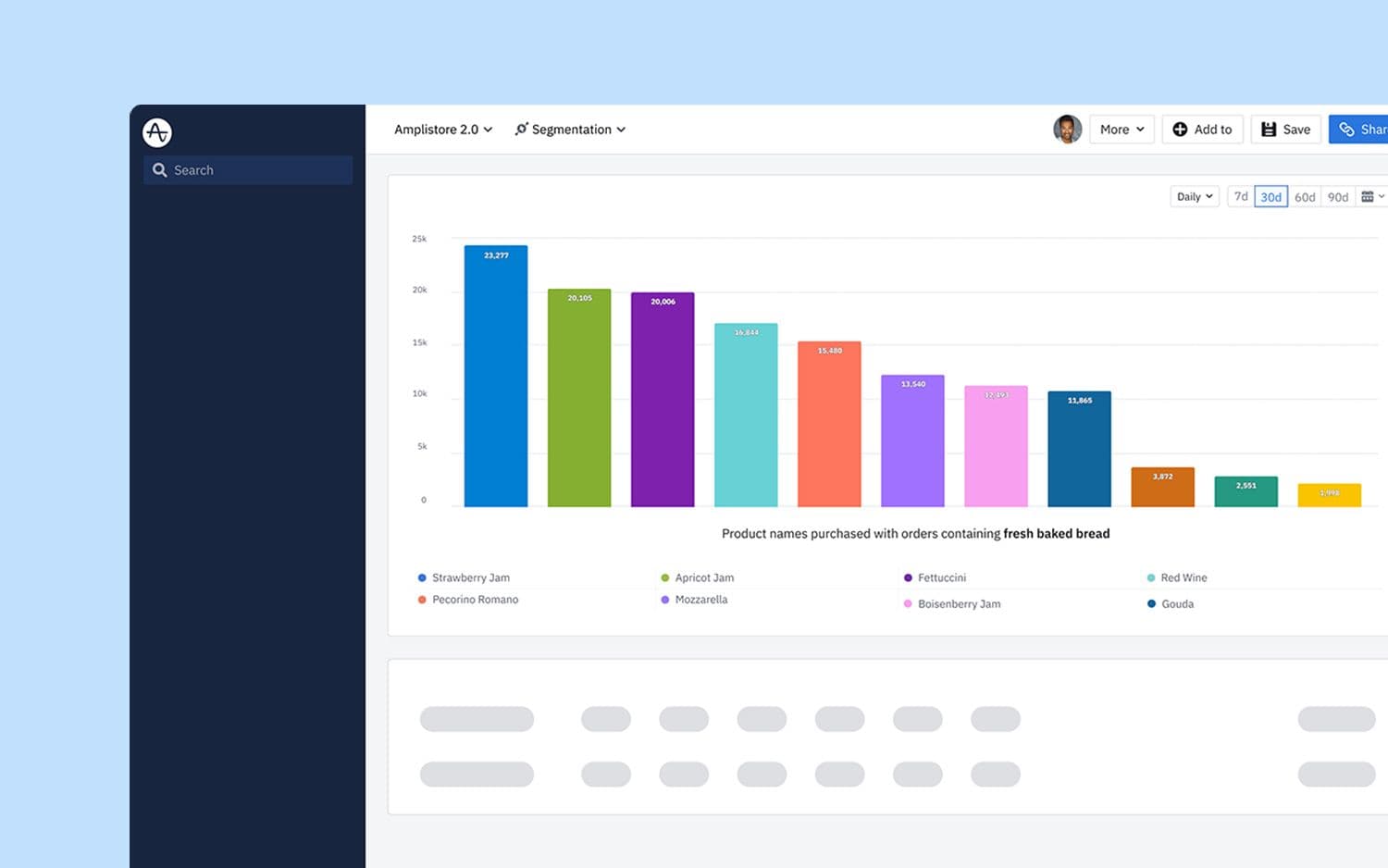Ecommerce Conversion Metrics Guide: Top 7 Metrics to Grow Your Business
Boost revenue and fine-tune your ecommerce strategy with our guide to ecommerce conversion metrics.
Cart Analysis helps you identify the most popular product combinations.Ecommerce conversion metrics measure how successful your ecommerce brand is at converting shoppers into customers. Conversion is the backbone of all ecommerce businesses—if your organization isn’t making money, it won’t survive for long.
The biggest misstep brands make when it comes to conversion metrics is tracking vanity metrics rather than figuring out what is impacting business outcomes. By contrast, leading businesses drill into the numbers to understand different conversion types and what customers do after they convert. This guide outlines key conversion metrics and considerations to help you measure what matters.
Alongside conversion, you’ll also want to track and analyze other parts of your business, like acquisition and retention. Read more in our ecommerce analytics guide.
Key Takeaways
- Revenue generation is the heart of any ecommerce business, which means measuring conversion is essential for success.
- Ecommerce conversion metrics can help you effectively turn potential customers into part of a loyal customer base.
- Drill into conversion metrics (for example, by comparing conversion across different types of products) to understand what drives high-value repeat purchases.
- There are seven main conversion metrics ecommerce businesses should track:
- Sales conversion rate
- Average order value (AOV)
- Percentage of returning customers
- Abandoned cart rate
- Average basket size
- Revenue by product and product category
- Top-performing product combinations
- Measuring conversion metrics is just the beginning—convert insights into actions through experimentation, refining your strategies for your online store.
Top seven metrics to measure
Here are the seven most important conversion metrics to track and some guidance for each.
1. Sales conversion rate
Your sales conversion rate measures the percentage of people who visit your ecommerce store and make a purchase. Calculate your ecommerce conversion rate from a specific period (e.g., one month or year) by dividing the number of completed purchases by the total number of ecommerce site and app visitors.
Formula
Sales conversion rate = Number of purchases / Number of visitors
Sales conversion rate is the most classic ecommerce metric because it helps you track the core health of your ecommerce business. Even small changes in your sales conversion rate can lead to a significant revenue increase (or decrease) over time.
This metric is also a key performance indicator (KPI) for any number of marketing or product efforts. You can track the sales conversion rate to understand whether your marketing campaigns are effective or if changes to your checkout flow drive more completed purchases.
Conversion rate optimization involves adjusting your ecommerce website or app and marketing efforts to make sure as many people as possible are completing a purchase.
Not all conversions are equal
Looking at your conversion rate in isolation can be misleading. For instance, many businesses see higher conversions during the holiday season. However, if all of those new conversions are one-off, low-value purchases, they won’t have a lasting impact on revenue and aren’t cause for celebration.
McKinsey research has found that focusing on building customer satisfaction and customer lifetime value (CLV) rather than getting individual sales helps companies be more profitable. To do that, analyze your conversions more deeply. Dig into your conversion rate by comparing conversion across:
- New vs. returning customers
- Product category
- Buyer location
- Platform or device type (e.g., desktop vs. mobile or iOS vs. Android)
Amplitude’s cart analysis makes it simple for non-data analysts to gather insights ontop-performing product categories, high-value customers, and popular product combinations. Using that information, they can update their ecommerce store to improve the number of high-value and repeat purchases.
Analyze personalization efforts
Sales conversion rate also helps you track the impact of your personalization efforts. Use it to see whether your personalized recommendations, ads, or content drove conversions. From there, you can iterate on your personalization strategies.
2. Average Order Value (AOV)
Average order value shows the average amount spent when a customer buys something from your digital sales channels. To measure AOV, divide revenue by the number of purchases during a specific time.
Formula
Average order value = Revenue / Purchases
Along with conversion rate, AOV is one of the most popular ecommerce product metrics to track because it’s an effective indicator of ecommerce business health. Increasing average order value is a fundamental lever of growth. Even with the same number of customers completing the same amount of purchases, you could directly increase revenue and potentially improve profit margins per order.
Track which products drive high-value conversions
AOV requires understanding what drives high-value conversions. Compare AOV across transactions containing specific products and product categories to see which kinds of products contribute most to high-value baskets.
3. Percentage of returning customers
The percentage of returning customers over a specific time shows you the number of new customers compared to repeat customers. Calculate it by dividing the number of returning customers by the total number of customers during a set amount of time—such as one week or month.
Formula
Percentage of returning customers = (Number of returning customers / Total customers) * 100
Most online businesses want to drive repeat purchases. Tracking the percentage of returning customers over time helps you determine whether your buying experience encourages people to return.
If you can acquire customers but struggle to get them to return, there could be friction in the customer experience after they make a purchase. For example, there may be problems with customer service or shipping that need resolving.
Track which products drive repeat business
Beyond looking at how many repeat customers you’re getting, you also want to understand the type of products that drive repeat purchases. Look into the order history of repeat buyers and identify which product or product category they purchase most frequently, or what they initially purchased.
4. Shopping cart abandonment rate
Shopping cart abandonment rate measures the amount of people who added items to their cart but didn’t go through the checkout process. To calculate your cart abandonment rate, divide the number of carts abandoned by the number of carts initiated.
Formula
Cart abandonment rate = Carts abandoned / Carts initiated
People who’ve added an item to their shopping cart show high intent to buy. When they don’t complete their transaction, it might reflect friction in the checkout flow, costing you revenue.
Cart abandonment rates are typically high. Baymard Institute benchmarks the average at almost 70%. Lowering your cart abandonment rate means directly improving your ecommerce revenue. Amplitude Journeys can help you discover where users are getting stuck before they can successfully check out.
5. Average basket size
Similar to AOV, average basket size measures the number of items people typically buy per order. Measure the average basket size by dividing the total number of items in customer baskets by the number of customers.
Formula
Average basket size = Total number of items in customer baskets / Total number of customers
Tracking average basket size helps you to understand your customers’ buying behavior. This information enables you to drive larger baskets and, in turn, revenue.
Average basket size is also helpful in analyzing the effectiveness of marketing promotions and campaigns. Compare average basket size before, during, and after the promotional period to see its impact.
6. Revenue by product and product category
Revenue by product and product category measures the revenue generated by different products. To see what percentage of revenue each product category brings in, divide the revenue for that category by the total revenue for that same period and multiply the result by 100.
Formula
Percentage of revenue from product category = (Revenue from that category / Total revenue) * 100
Repeat the calculation across different categories and compare the results. To analyze individual product performance, use revenue from that specific product rather than the category. Additionally, to analyze the performance of products within a category, divide the revenue from each product within that category by the total revenue from that category.
Analyzing revenue by product and product category enables you to identify top and underperforming products. Use the data to adjust your product portfolio and pricing strategy to make them as effective as possible. You might decide to rethink the promotion, product pages, or pricing of underperforming products or cut them altogether.
Track the revenue of different types of products over time to understand which products are typically in demand at different times of the year. Revenue analysis across products helps with inventory management and demand forecasting so you always have the right products in stock.
7. Top-performing product combinations
Identifying top-performing product combinations involves a set of analyses rather than an individual metric. Cart Analysis in Amplitude enables you to create a chart for any product and discover which products people usually buy alongside it.
For example, a grocery store might find that the average customer tends to buy strawberry jam with freshly baked bread.

Cart Analysis helps you identify the most popular product combinations.
When you know which products customers tend to buy together, you can suggest them as recommended items to drive cross-selling and increase average order value.
Analyze, then take action
Measuring metrics and running analyses is all about gathering information. But what do you do next?
Experimentation helps you improve your strategies, move metrics in the right direction, and improve your bottom line. Use conversion metrics as a starting point to identify where you can refine your ecommerce strategy.
From there, try out adjustments to the customer experience. For instance, you might double down on a successful marketing channel (such as email marketing, SEO, or paid ads) or add a pop-up with personalized product recommendations. Run A/B testing to find the best messaging and design for your ecommerce site, social media posts, and ads. Measure the results, then analyze and repeat.
Discover what stops customers from converting by diagnosing friction in your ecommerce sales funnel. This Amplitude worksheet and companion dashboard will guide you through funnel analysis and help you decide where to focus your efforts.

Ganit Bar-Dor
Sr. Director, Global Professional Services, Amplitude
Ganit Bar-Dor manages Technical Services & Success at Amplitude, working with companies to gain actionable insights and effectively manage their data. She has worn many hats within professional services and product teams, building, executing and consulting with customers. Ganit Bar-Dor graduated from Concordia University in Montreal, Canada, with a degree in Computer Science.
More from Ganit




